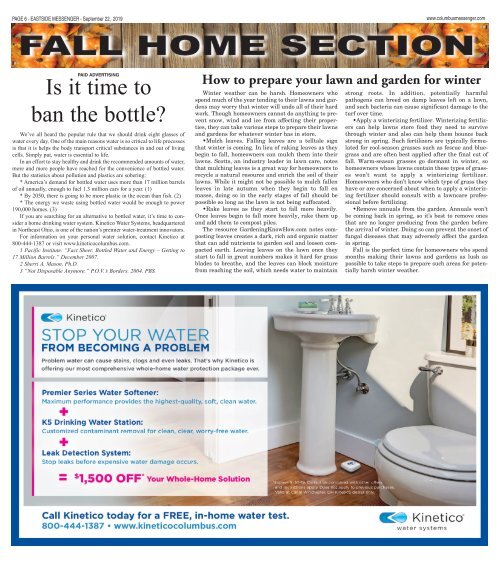Eastside Messenger - September 22nd, 2019
You also want an ePaper? Increase the reach of your titles
YUMPU automatically turns print PDFs into web optimized ePapers that Google loves.
PAGE 6 - EASTSIDE MESSENGER - <strong>September</strong> 22, <strong>2019</strong><br />
www.columbusmessenger.com<br />
PAID ADVERTISING<br />
Is it time to<br />
ban the bottle?<br />
We’ve all heard the popular rule that we should drink eight glasses of<br />
water every day. One of the main reasons water is so critical to life processes<br />
is that it is helps the body transport critical substances in and out of living<br />
cells. Simply put, water is essential to life.<br />
In an effort to stay healthy and drink the recommended amounts of water,<br />
more and more people have reached for the convenience of bottled water.<br />
But the statistics about pollution and plastics are sobering:<br />
* America’s demand for bottled water uses more than 17 million barrels<br />
of oil annually, enough to fuel 1.3 million cars for a year. (1)<br />
* By 2050, there is going to be more plastic in the ocean than fish. (2)<br />
* The energy we waste using bottled water would be enough to power<br />
190,000 homes. (3)<br />
If you are searching for an alternative to bottled water, it’s time to consider<br />
a home drinking water system. Kinetico Water Systems, headquartered<br />
in Northeast Ohio, is one of the nation’s premier water-treatment innovators.<br />
For information on your personal water solution, contact Kinetico at<br />
800-444-1387 or visit www.kineticocolumbus.com.<br />
1 Pacific Institute. “Fact Sheet: Bottled Water and Energy – Getting to<br />
17 Million Barrels.” December 2007.<br />
2 Sherri A. Mason, Ph.D.<br />
3 “Not Disposable Anymore.” P.O.V.’s Borders. 2004. PBS.<br />
How to prepare your lawn and garden for winter<br />
Winter weather can be harsh. Homeowners who<br />
spend much of the year tending to their lawns and gardens<br />
may worry that winter will undo all of their hard<br />
work. Though homeowners cannot do anything to prevent<br />
snow, wind and ice from affecting their properties,<br />
they can take various steps to prepare their lawns<br />
and gardens for whatever winter has in store.<br />
•Mulch leaves. Falling leaves are a telltale sign<br />
that winter is coming. In lieu of raking leaves as they<br />
begin to fall, homeowners can mulch them into their<br />
lawns. Scotts, an industry leader in lawn care, notes<br />
that mulching leaves is a great way for homeowners to<br />
recycle a natural resource and enrich the soil of their<br />
lawns. While it might not be possible to mulch fallen<br />
leaves in late autumn when they begin to fall en<br />
masse, doing so in the early stages of fall should be<br />
possible so long as the lawn is not being suffocated.<br />
•Rake leaves as they start to fall more heavily.<br />
Once leaves begin to fall more heavily, rake them up<br />
and add them to compost piles.<br />
The resource GardeningKnowHow.com notes composting<br />
leaves creates a dark, rich and organic matter<br />
that can add nutrients to garden soil and loosen compacted<br />
earth. Leaving leaves on the lawn once they<br />
start to fall in great numbers makes it hard for grass<br />
blades to breathe, and the leaves can block moisture<br />
from reaching the soil, which needs water to maintain<br />
strong roots. In addition, potentially harmful<br />
pathogens can breed on damp leaves left on a lawn,<br />
and such bacteria can cause significant damage to the<br />
turf over time.<br />
•Apply a winterizing fertilizer. Winterizing fertilizers<br />
can help lawns store food they need to survive<br />
through winter and also can help them bounce back<br />
strong in spring. Such fertilizers are typically formulated<br />
for cool-season grasses such as fescue and bluegrass<br />
and are often best applied after the final cut of<br />
fall. Warm-season grasses go dormant in winter, so<br />
homeowners whose lawns contain these types of grasses<br />
won’t want to apply a winterizing fertilizer.<br />
Homeowners who don’t know which type of grass they<br />
have or are concerned about when to apply a winterizing<br />
fertilizer should consult with a lawncare professional<br />
before fertilizing.<br />
•Remove annuals from the garden. Annuals won’t<br />
be coming back in spring, so it’s best to remove ones<br />
that are no longer producing from the garden before<br />
the arrival of winter. Doing so can prevent the onset of<br />
fungal diseases that may adversely affect the garden<br />
in spring.<br />
Fall is the perfect time for homeowners who spend<br />
months making their lawns and gardens as lush as<br />
possible to take steps to prepare such areas for potentially<br />
harsh winter weather.


















